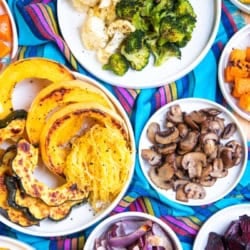
Roasted Vegetables
Master the art of roasting vegetables with this foolproof guide! No matter which vegetables you're working with, roasting at 425°F (220°C) brings out their natural sweetness and gives them that irresistible caramelized finish. Use this method with any vegetable, adjusting the time as needed.
Equipment
- Sheet pan
Ingredients
For roasting:
- 1 TBSP olive oil
- 2 cups prepped raw vegetables see recipe notes for prepping tips.
- salt to taste
- pepper to taste
Instructions
Basic Formula for Roasting Any Vegetable:
- Cut into uniform pieces for even cooking.
- Toss with olive oil, salt, and pepper (or other seasonings of choice).
- Spread in a single layer on a baking sheet, leaving space between pieces.
- Roast at 425°F (220°C), stirring halfway through.
- Remove when tender and golden brown (see timing guide below).
Step by Step Roasting Instructions:
- Preheat the oven to 425°F (220°C). Line a baking sheet with parchment paper.
- Prep the vegetables. Wash and cut them into uniform pieces according to the roasting time guidelines below.
- Toss with oil and seasoning. Use about 1 TBSP of olive oil per 2 cups of vegetables. Sprinkle with salt and pepper, or experiment with other seasonings.
- Arrange on the baking sheet. Spread in a single layer with space between them—crowding leads to steaming instead of roasting.
Roast according to the guide:
- If roasting multiple vegetables, start with the longest-cooking ones first.Long Roast (30-40 minutes) : Beets (quartered) – 30-35 minutes. Butternut squash (diced) – 30-35 minutes. Acorn squash & spaghetti squash (½-inch rings) – 30-35 minutes. Green cabbage (wedges) – 30-35 minutes.
- Add moderate-cooking vegetables after 10 minutes.Medium Roast (20-30 minutes):Mushrooms (sliced) – 20-25 minutes. Broccoli & cauliflower (florets) – 20-25 minutes. Carrots (diced) – 25-30 minutes. Sweet potatoes (diced) – 25-30 minutes. Radishes (quartered) – 20-25 minutes. Brussels sprouts (halved) – 25-30 minutes. Red onion (sliced) – 20-25 minutes. Small potatoes (halved or quartered) – 25-30 minutes.
- Add quick-cooking vegetables in the last 10-15 minutes. Light Roast (10-15 minutes):Bell peppers (sliced) – 10-15 minutes. Zucchini & yellow squash (sliced, seeds removed) – 10-12 minutes. Asparagus (woody stems removed) – 12-15 minutes.
- Stir or flip halfway through to ensure even browning.
- Check for doneness. Vegetables are ready when they are tender and have golden, crispy edges. Remove any that finish early.
- Serve immediately or store for meal prep
Video
Notes
To store:
Allow to cool and store refrigerated in an airtight container for up to 5 days. Proper Prep is Key Before you even think about turning on that oven, your vegetables need to be prepped accordingly:
Allow to cool and store refrigerated in an airtight container for up to 5 days. Proper Prep is Key Before you even think about turning on that oven, your vegetables need to be prepped accordingly:
-
- Soak Oxidizing Vegetables – Vegetables like potatoes and white sweetpotatoes can oxidize quickly. Soaking them in cold water for 15-30 minutes before roasting helps maintain their color and texture.
-
- Wash and dry Thoroughly. Excess moisture leads to steaming, not roasting. Dry your veggies very well with a towel.
-
- Peel If Desired – Some vegetables, like sweetpotatoes, can be left unpeeled for extra texture and nutrients. Others, like butternut squash, benefit from peeling.
-
- Cut for Even Cooking – Keep everything uniform in size so that each piece roasts in the same amount of time.
-
- Remove Seeds from Watery Vegetables – The seed sacks in zucchini and summer squash hold excess moisture, which can make them watery and lack luster when roasted. Cut the core of the squash out before roasting for a firmer, better texture.
Nutrition
Calories: 323kcalCarbohydrates: 48gProtein: 3gFat: 15gSaturated Fat: 2gPolyunsaturated Fat: 2gMonounsaturated Fat: 11gSodium: 27mgPotassium: 998mgFiber: 13gSugar: 13gVitamin C: 45mgCalcium: 96mgIron: 2mg
Tried this recipe?Mention @cagrownofficial or tag #CAGROWN!